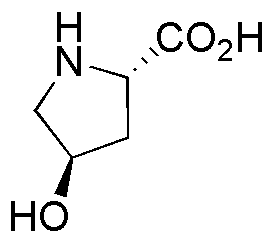trans-L-4-Hydroxyproline is widely utilized in research focused on:
- Pharmaceutical Development: This compound is used in the synthesis of various pharmaceuticals, particularly in the development of drugs targeting collagen-related diseases, enhancing skin health and wound healing.
- Cosmetic Formulations: Its ability to improve skin elasticity and hydration makes it a popular ingredient in anti-aging creams and serums, providing a natural alternative to synthetic compounds.
- Food Industry: As a non-animal derived amino acid, it is incorporated into dietary supplements and functional foods aimed at enhancing collagen production, appealing to health-conscious consumers.
- Biotechnology: Researchers utilize trans-L-4-Hydroxyproline in protein engineering and peptide synthesis, aiding in the development of novel biomaterials with enhanced properties.
- Research on Fibrosis: It serves as a valuable tool in studies related to fibrosis and tissue repair, helping scientists understand and potentially mitigate scarring and tissue damage.
General Information
Properties
Safety and Regulations
Applications
trans-L-4-Hydroxyproline is widely utilized in research focused on:
- Pharmaceutical Development: This compound is used in the synthesis of various pharmaceuticals, particularly in the development of drugs targeting collagen-related diseases, enhancing skin health and wound healing.
- Cosmetic Formulations: Its ability to improve skin elasticity and hydration makes it a popular ingredient in anti-aging creams and serums, providing a natural alternative to synthetic compounds.
- Food Industry: As a non-animal derived amino acid, it is incorporated into dietary supplements and functional foods aimed at enhancing collagen production, appealing to health-conscious consumers.
- Biotechnology: Researchers utilize trans-L-4-Hydroxyproline in protein engineering and peptide synthesis, aiding in the development of novel biomaterials with enhanced properties.
- Research on Fibrosis: It serves as a valuable tool in studies related to fibrosis and tissue repair, helping scientists understand and potentially mitigate scarring and tissue damage.
Documents
Safety Data Sheets (SDS)
The SDS provides comprehensive safety information on handling, storage, and disposal of the product.
Product Specification (PS)
The PS provides a comprehensive breakdown of the product’s properties, including chemical composition, physical state, purity, and storage requirements. It also details acceptable quality ranges and the product's intended applications.
Certificates of Analysis (COA)
Search for Certificates of Analysis (COA) by entering the products Lot Number. Lot and Batch Numbers can be found on a product’s label following the words ‘Lot’ or ‘Batch’.
*Catalog Number
*Lot Number
Certificates Of Origin (COO)
This COO confirms the country where the product was manufactured, and also details the materials and components used in it and whether it is derived from natural, synthetic, or other specific sources. This certificate may be required for customs, trade, and regulatory compliance.
*Catalog Number
*Lot Number
Safety Data Sheets (SDS)
The SDS provides comprehensive safety information on handling, storage, and disposal of the product.
DownloadProduct Specification (PS)
The PS provides a comprehensive breakdown of the product’s properties, including chemical composition, physical state, purity, and storage requirements. It also details acceptable quality ranges and the product's intended applications.
DownloadCertificates of Analysis (COA)
Search for Certificates of Analysis (COA) by entering the products Lot Number. Lot and Batch Numbers can be found on a product’s label following the words ‘Lot’ or ‘Batch’.
*Catalog Number
*Lot Number
Certificates Of Origin (COO)
This COO confirms the country where the product was manufactured, and also details the materials and components used in it and whether it is derived from natural, synthetic, or other specific sources. This certificate may be required for customs, trade, and regulatory compliance.


